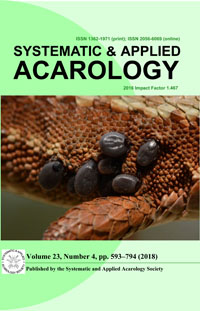The morphological ontogeny of Protoribates dentatus (Berlese, 1883) is described and illustrated. The juveniles of P. dentatus are elongated, oval in cross section, and their prodorsal, gastronotal setae and most setae on the legs are thin, smooth or with short barbs, which is typical of xylophages. Typical for this group is also a posterior position of the anal opening and relatively thick leg segments and claws, especially on leg I. The larva of P. dentatus has 11 pairs of gastronotal setae, including h2; and setae c2, la and lm are with excentrosclerites. The nymphs have 15 pairs of setae, of which c2 l- and h-series are with excentrosclerites. The adult of this species has a long seta ad1 (which is short in most congeners) and the number of claws varies on all leg tarsi.
How to translate text using browser tools
26 March 2018
Morphological ontogeny of Protoribates dentatus (Acari, Oribatida, Haplozetidae)
Stanisław Seniczak,
Anna seniczak,
Sławomir Kaczmarek,
Tomasz Marquardt
ACCESS THE FULL ARTICLE

Systematic and Applied Acarology
Vol. 23 • No. 4
April 2018
Vol. 23 • No. 4
April 2018




